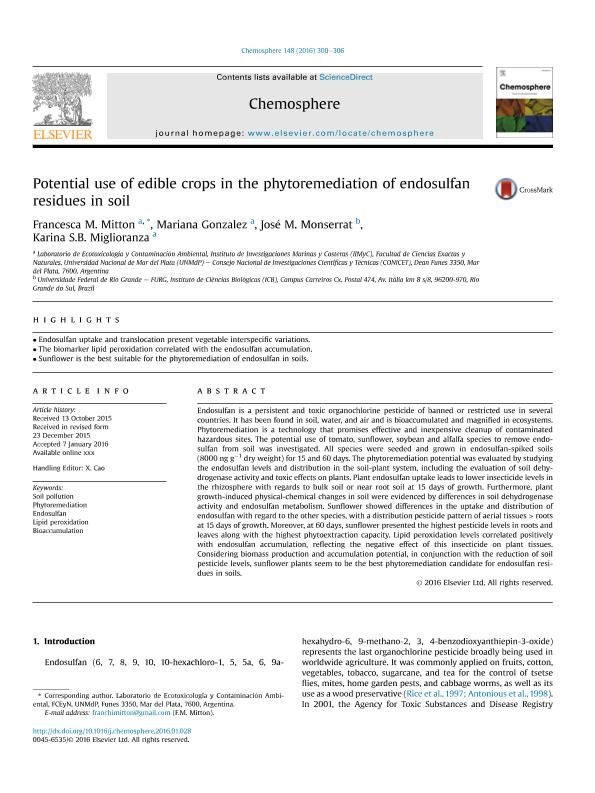Artículo
Potential use of edible crops in the phytoremediation of endosulfan residues in soil
Mitton, Francesca María ; Gonzalez, Mariana
; Gonzalez, Mariana ; Monserrat, José María; Miglioranza, Karina Silvia Beatriz
; Monserrat, José María; Miglioranza, Karina Silvia Beatriz
 ; Gonzalez, Mariana
; Gonzalez, Mariana ; Monserrat, José María; Miglioranza, Karina Silvia Beatriz
; Monserrat, José María; Miglioranza, Karina Silvia Beatriz
Fecha de publicación:
04/2016
Editorial:
Pergamon-Elsevier Science Ltd
Revista:
Chemosphere
ISSN:
0045-6535
Idioma:
Inglés
Tipo de recurso:
Artículo publicado
Clasificación temática:
Resumen
Endosulfan is a persistent and toxic organochlorine pesticide of banned or restricted use in several countries. It has been found in soil, water, and air and is bioaccumulated and magnified in ecosystems. Phytoremediation is a technology that promises effective and inexpensive cleanup of contaminated hazardous sites. The potential use of tomato, sunflower, soybean and alfalfa species to remove endosulfan from soil was investigated. All species were seeded and grown in endosulfan-spiked soils (8000 ng g-1 dry weight) for 15 and 60 days. The phytoremediation potential was evaluated by studying the endosulfan levels and distribution in the soil-plant system, including the evaluation of soil dehydrogenase activity and toxic effects on plants. Plant endosulfan uptake leads to lower insecticide levels in the rhizosphere with regards to bulk soil or near root soil at 15 days of growth. Furthermore, plant growth-induced physical-chemical changes in soil were evidenced by differences in soil dehydrogenase activity and endosulfan metabolism. Sunflower showed differences in the uptake and distribution of endosulfan with regard to the other species, with a distribution pesticide pattern of aerial tissues > roots at 15 days of growth. Moreover, at 60 days, sunflower presented the highest pesticide levels in roots and leaves along with the highest phytoextraction capacity. Lipid peroxidation levels correlated positively with endosulfan accumulation, reflecting the negative effect of this insecticide on plant tissues. Considering biomass production and accumulation potential, in conjunction with the reduction of soil pesticide levels, sunflower plants seem to be the best phytoremediation candidate for endosulfan residues in soils.
Archivos asociados
Licencia
Identificadores
Colecciones
Articulos(IIMYC)
Articulos de INSTITUTO DE INVESTIGACIONES MARINAS Y COSTERAS
Articulos de INSTITUTO DE INVESTIGACIONES MARINAS Y COSTERAS
Citación
Mitton, Francesca María; Gonzalez, Mariana; Monserrat, José María; Miglioranza, Karina Silvia Beatriz; Potential use of edible crops in the phytoremediation of endosulfan residues in soil; Pergamon-Elsevier Science Ltd; Chemosphere; 148; 4-2016; 300-306
Compartir
Altmétricas



